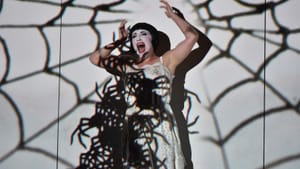Stay in the Loop
BSR publishes on a weekly schedule, with an email newsletter every Wednesday and Thursday morning. There’s no paywall, and subscribing is always free.
Mozart meets Murnau (sort of)
Opera Philadelphia's O17 Festival presents 'The Magic Flute (Die Zauberflöte)'

There’s no such thing as a “normal” staging of The Magic Flute (Die Zauberflöte). Equal parts fairy tale and philosophical treatise, Mozart’s penultimate opera dares directors to make sense of his fascination with Masonic symbolism, animal imagery, and human–spirit hybrids. Visual artists as varied as Marc Chagall and David Hockney created highly conceptualized productions long before abstraction became the fashion in opera. This fanciful production comes to town as part of Opera Philadelphia’s O17 Festival, a citywide celebration of the art form.
You’ll be forgiven if you leave wondering what all the fuss is about.
The silents get too noisy
Barrie Kosky and Suzanne Andrade’s take on the piece has gathered various encomiums since it premiered at Berlin’s Komische Oper in 2012. The driving influence appears to be silent film: all of Emanuel Schikaneder’s dialogue has been replaced by title cards, underscored by an honest-to-goodness piano accompanist (this trick grows tiresome almost immediately).
The performers are styled after stars of the era: Pamina (Rachel Sterrenberg) resembles Louise Brooks; the bird-catcher Papageno (Jarrett Ott) becomes Buster Keaton; Tamino (Ben Bliss) seems to be George Valentin, the protagonist of the modern pastiche The Artist. The evil Monostatos (Brenton Ryan) is a dead ringer for Graf Orlok, the still-terrifying villain of Murnau’s Nosferatu.
Kosky and Andrade produce visually arresting images. The entire set consists of a unit-sized film screen. A series of projected backdrops stand in for the opera’s various realms: the temple of Sarastro, the Masonic priest; the terrifying lair of the Queen of the Night, Pamina’s vindictive mother. These projections (designed by Paul Barritt) solve some of the piece’s more common staging problems, like how best to represent Papageno’s feathered friends or the serpent who tries to swallow Tamino in the opera’s opening scene.
But if modern technology allows for pictorial representations beyond Mozart’s wildest imagination, these directors and designers fail to establish visual or tonal consistency. Sometimes the projections call to mind the works of Schiele and Klimt; at other points, they closely resemble scenes from contemporary video games. Pop art, political cartoons, and classic comic books also make an appearance. These factors largely feel out of place in a production concept shaped by early film. After all, Cecil B. DeMille never played World of Warcraft.
Technology vs. humanity
Kosky and Andrade should have chosen a thematic strand and stuck with it. I would have appreciated a deeper connection to German Expressionist reference points: the opera’s dreamlike elements would pair well with that movement’s highly stylized view of life, where beautiful and grotesque sit side by side. The period’s fractious views of nature, religion, and romantic love also match Mozart and Schikaneder’s conception of human relationships. As it stands, the directors collapse under the anxiety of influence as they try to be all things to all people.

These flaws might have been less evident had the production’s musical virtues been outstanding. But on opening night, conductor David Charles Abell led a reading of the score I’ll charitably describe as workmanlike. And both Sterrenberg (a frequent Opera Philadelphia artist) and Olga Pudova, as Queen of the Night, showed signs of vocal distress. A troubling beat has crept into Sterrenberg’s once-crystalline soprano; to compensate, she sang cautiously and blandly. Pudova coaxed the treacherous high Fs required for the Queen’s famous aria “Der Hölle Rache kocht in meinem herzen” (“The fury of Hell cooks in my heart”) but, to this listener, it was an unpleasant exercise.
Bliss and Ott earn high marks for beautiful lyric singing and crisp German diction. Neither gives a particularly interesting performance, but that’s largely the production’s fault. They’ve been directed to deliver the music stock-still and let the flickering images do the work. These are thinly drawn characters to begin with; why rob them of the little humanity they possess?
Many will be dazzled by the technological feats achieved here. But opera has always existed primarily as an expression of the human spirit. In that respect, this Flute quickly falls out of tune.
What, When, Where
The Magic Flute (Die Zauberflöte). By Wolfgang Amadeus Mozart and Emanuel Schikaneder, David Charles Abell conducted, Barrie Kosky and Suzanne Andrade directed. Opera Philadelphia. Through September 24, 2017, at the Academy of Music, 240 S. Broad Street, Philadelphia. (215) 732-8400 or operaphila.org.
Sign up for our newsletter
All of the week's new articles, all in one place. Sign up for the free weekly BSR newsletters, and don't miss a conversation.

 Cameron Kelsall
Cameron Kelsall